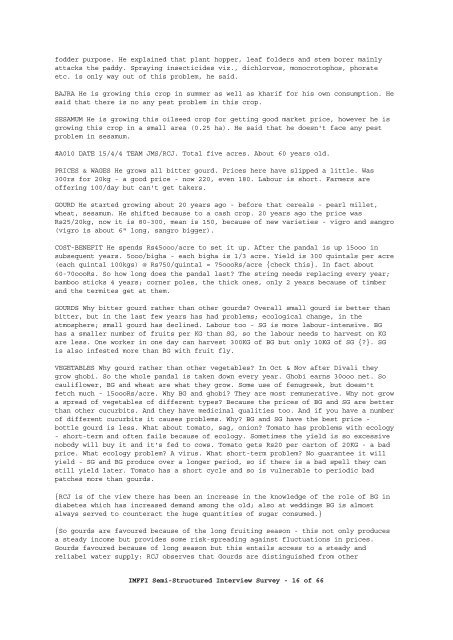“Key Informant Survey” of Production, Value, Losses and ... - DfID
“Key Informant Survey” of Production, Value, Losses and ... - DfID
“Key Informant Survey” of Production, Value, Losses and ... - DfID
Create successful ePaper yourself
Turn your PDF publications into a flip-book with our unique Google optimized e-Paper software.
fodder purpose. He explained that plant hopper, leaf folders <strong>and</strong> stem borer mainly<br />
attacks the paddy. Spraying insecticides viz., dichlorvos, monocrotophos, phorate<br />
etc. is only way out <strong>of</strong> this problem, he said.<br />
BAJRA He is growing this crop in summer as well as kharif for his own consumption. He<br />
said that there is no any pest problem in this crop.<br />
SESAMUM He is growing this oilseed crop for getting good market price, however he is<br />
growing this crop in a small area (0.25 ha). He said that he doesn't face any pest<br />
problem in sesamum.<br />
#A010 DATE 15/4/4 TEAM JMS/RCJ. Total five acres. About 60 years old.<br />
PRICES & WAGES He grows all bitter gourd. Prices here have slipped a little. Was<br />
300rs for 20kg - a good price - now 220, even 180. Labour is short. Farmers are<br />
<strong>of</strong>fering 100/day but can't get takers.<br />
GOURD He started growing about 20 years ago - before that cereals - pearl millet,<br />
wheat, sesamum. He shifted because to a cash crop. 20 years ago the price was<br />
Rs25/20kg, now it is 80-300, mean is 150, because <strong>of</strong> new varieties - vigro <strong>and</strong> sangro<br />
(vigro is about 6" long, sangro bigger).<br />
COST-BENEFIT He spends Rs45ooo/acre to set it up. After the p<strong>and</strong>al is up 15ooo in<br />
subsequent years. 5ooo/bigha - each bigha is 1/3 acre. Yield is 300 quintals per acre<br />
(each quintal 100kgs) @ Rs750/quintal = 75oooRs/acre {check this}. In fact about<br />
60-70oooRs. So how long does the p<strong>and</strong>al last? The string needs replacing every year;<br />
bamboo sticks 4 years; corner poles, the thick ones, only 2 years because <strong>of</strong> timber<br />
<strong>and</strong> the termites get at them.<br />
GOURDS Why bitter gourd rather than other gourds? Overall small gourd is better than<br />
bitter, but in the last few years has had problems; ecological change, in the<br />
atmosphere; small gourd has declined. Labour too - SG is more labour-intensive. BG<br />
has a smaller number <strong>of</strong> fruits per KG than SG, so the labour needs to harvest on KG<br />
are less. One worker in one day can harvest 300KG <strong>of</strong> BG but only 10KG <strong>of</strong> SG {?}. SG<br />
is also infested more than BG with fruit fly.<br />
VEGETABLES Why gourd rather than other vegetables? In Oct & Nov after Divali they<br />
grow ghobi. So the whole p<strong>and</strong>al is taken down every year. Ghobi earns 30ooo net. So<br />
cauliflower, BG <strong>and</strong> wheat are what they grow. Some use <strong>of</strong> fenugreek, but doesn't<br />
fetch much - 15oooRs/acre. Why BG <strong>and</strong> ghobi? They are most remunerative. Why not grow<br />
a spread <strong>of</strong> vegetables <strong>of</strong> different types? Because the prices <strong>of</strong> BG <strong>and</strong> SG are better<br />
than other cucurbits. And they have medicinal qualities too. And if you have a number<br />
<strong>of</strong> different cucurbits it causes problems. Why? BG <strong>and</strong> SG have the best price -<br />
bottle gourd is less. What about tomato, sag, onion? Tomato has problems with ecology<br />
- short-term <strong>and</strong> <strong>of</strong>ten fails because <strong>of</strong> ecology. Sometimes the yield is so excessive<br />
nobody will buy it <strong>and</strong> it's fed to cows. Tomato gets Rs20 per carton <strong>of</strong> 20KG - a bad<br />
price. What ecology problem? A virus. What short-term problem? No guarantee it will<br />
yield - SG <strong>and</strong> BG produce over a longer period, so if there is a bad spell they can<br />
still yield later. Tomato has a short cycle <strong>and</strong> so is vulnerable to periodic bad<br />
patches more than gourds.<br />
{RCJ is <strong>of</strong> the view there has been an increase in the knowledge <strong>of</strong> the role <strong>of</strong> BG in<br />
diabetes which has increased dem<strong>and</strong> among the old; also at weddings BG is almost<br />
always served to counteract the huge quantities <strong>of</strong> sugar consumed.}<br />
{So gourds are favoured because <strong>of</strong> the long fruiting season - this not only produces<br />
a steady income but provides some risk-spreading against fluctuations in prices.<br />
Gourds favoured because <strong>of</strong> long season but this entails access to a steady <strong>and</strong><br />
reliabel water supply: RCJ observes that Gourds are distinguished from other<br />
IMFFI Semi-Structured Interview Survey - 16 <strong>of</strong> 66

















